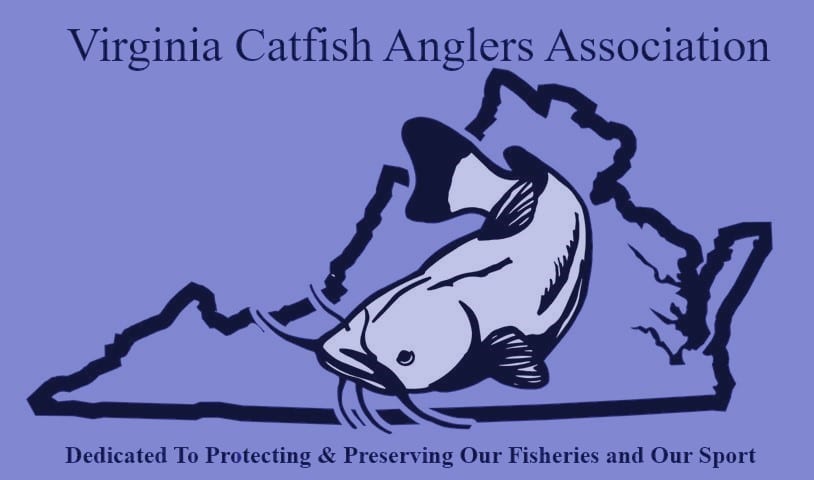Pam Dudding
Contributing writer
Because fish is heart-healthy meat for human consumption, the sport of fishing has been around for thousands of years. There has been a concern, however, that the fish population is being depleted in local areas of Virginia.

The Virginia Catfish Anglers Association is a conservation group aimed at representing the catfish fisheries and the sport of Catfish Angling across the Commonwealth of Virginia. In April, Jonathan Looney established the Virginia Catfish Anglers Association to help other fishing advocates to preserve the sport. Looney is also the Chief at the Johns Creek Fire Department in Craig County.
In April, Jonathan Looney established the Virginia Catfish Anglers Association to help other fishing advocates preserve the sport. Looney is also the Chief at the Johns Creek Fire Department in Craig County.
“I’ve been fishing on the lower James for 13 years,” said Looney who started his fishing from the shore and later enjoyed it from a boat. “The James use to have the highest population of trophy blue catfish in the country.”
Businesses depend on anglers for their income. When ‘The King of the James Tournament’ was held, every motel within 20 miles sold out. “It was the first time in over a decade that everything was completely booked,” Looney added.
Looney believes that the huge increase of commercial harvesting operations have endangered several species of fish in the James River as well as other rivers and lakes throughout Virginia.
Looney noted that, “In 2003, approximately 10,000 blue catfish were pulled and of those, 20 percent were 30 inches or larger. Since then, commercial fishing has become a big push. In a 2017 study, the 30 inch or greater fish reduced drastically to 1.26 percent.”
Looney’s concern is that soon there will be nothing to draw anglers to the areas.
He added that in 2000, James River was a peak fishery, recognized as a top 10 blue catfish spot. “The number of tour guides skyrocketed,” he said. “Businesses evolved around cat fisheries. Now, it’s not even in the top 15.”
The Virginia Marine Resources Commission recently considered reinstating electrofishing permits and adding additional permits to allow multiple electro boats to commercially harvest catfish from public waters in Virginia.
“Just one boat can pull out 3.46 million pounds of fish,” Looney said. “What will four boats do to the fish population?”
Statistics show that in 2017 the Commercial Blue Catfish Harvest from Public Waters in Virginia soared to 3,460,745, according to official reports, which accounted for more than one-third of the reported national harvest of Blue Catfish.
Looney explained that they use specialized electronic equipment that emits an electrical charge into the water stunning any fish in the range of current. The fish are then scooped into nets and taken.
“This drastically furthers a commercial fishery that is operating with almost no regulations, enforcement and has an unlimited harvest ruling in place by the state,” Looney noted. “The removal of these fish have a massive impact on our fisheries due to the high mortality rate of catfish fry and the fact that it takes up to 20 years for them to reach this size and reproductive level.”
One crucial fact that Looney stressed was that the Anglers produce more income than the harvesters. “In 2017, anglers spent 1.4 billion in Virginia,” he said.
Another serious concern is the fact that this harvesting is allowed seven days a week, 24 hours a day. “And, they keep everything they catch,” Looney said. “They even harvest during spawning season which can drive particular fish species into extinction.”
The Atlantic Sturgeon is the largest fish species on the East Coast as well as the longest-lived creature that reproduces in the North American Rivers. “It has been absent in the James for a while due to caviar boom in the 50s, 60s and 70s,” Looney explained.
The concern is that with the population starting to slowly increase since its 2015 protection, no study has been conducted to see what the electro boat will have on its presence. “The adolescent remains in the river until they are big enough to go to sea,” Looney said. “So, this may impact an already endangered species.”
A more pressing fact is that Virginia Department of Health has strict advisories in place regarding the human consumption of these catfish from waters as they are tested having high concentrations of PCB, suggesting no more than a 2.4 ounce serving per person only twice a month.
The Anglers believe these fish are being taken and sold everywhere as fresh wild-caught local catfish.
“It’s also been noted that over-harvesting, lack of regulations and monitoring has just recently lead to the closing of the Striper fisheries here in Virginia due to drastic population decline. It has to be our goal to prevent catfish from following the same path to the same end result,” Looney said.
He added, “With these facts out there, our group needs everyone’s support and desperately needs the strength of members to address these issues. For campaigns like ours to take on established entities and the state legislature to get proper regulations, it takes strength in numbers.”
Interested individuals can connect with Looney on his personal Facebook (facebook.com/groups/342669453034910/?ref=share) or the Virginia Catfish Anglers Association.
“Help us put a permanent stop to these vicious and destructive operations. Our fisheries, the Catfish Angling sport, the livelihood of local businesses and guides are on the line here,” Looney said. “It is up to us to ensure that our fisheries are sustainable, and catfish are here for future generations to enjoy.”



